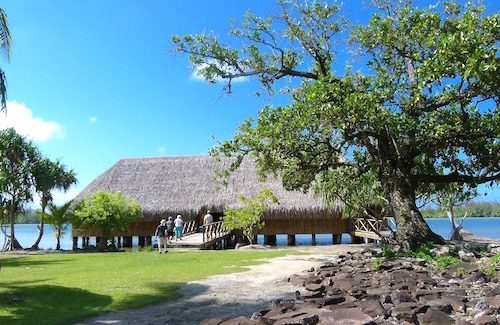Shore Excursion: Visiting historic marae on island of Huahine
By Jackie Sheckler Finch
The South Polynesian island of Huahine is said to have the best-preserved historic marae on the islands so that was the shore excursion I chose when our ship docked.
So far, the marae I have seen look like piles of rocks or elevated land. If a tour guide and info signs didn’t describe what I was seeing, I probably would not have known the historic significance of the pre-European temples.
Tour guide Georgette was fluent in English and in information. While we rode on our flower-draped bus, Georgette told us that Huahine has only one main road around the island, about 6,500 residents, eight little villages, three small hotels and the island’s economy relies mainly on agriculture, fishing and tourism.
Known as “The Garden Island,” Huahine grows abundant vanilla, melons, breadfruit and bananas. One of the least touristy Polynesian islands, Huahine has an interior that is largely undeveloped and uninhabited, leading to its reputation as being the island least changed by the modern world.
Georgette also pointed out that Huahine is actually two islands – Huahine Nui (Big Huahine) and Huahine Iti (Little Huahine) – basking in one lagoon with a bridge joining them. At one time, it is believed that Huahine was one island. Since these volcanic islands are slowly sinking into the sea, the two highest portions of the original Huahine are what show above the surface of the ocean today. Mythology claims that the two islands were created when the god Hiro cut a big island in half with his canoe.
“Before they built the bridge, we would have to go back and forth between the two islands in a canoe,” Georgette said. “We are very happy to have the bridge.”
Originally, Georgette said, Huahine was named Hermosa – Spanish for “beautiful” – by Captain James Cook in 1769. But folks called it Huahine instead because the rolling hills seem shaped like a pregnant woman lying down on her back. That sight can most clearly be seen from the air or in the island’s main town of Fare. Georgette pointed it out and I took a photo but, to me, it mostly looked like the peaks and valleys of beautiful hills.
Our stop at Maeva Archaeology Site showcased the best marae I have seen since arriving in French Polynesia. In ancient Polynesia, the open-air sanctuaries were large sacred temples where important events took place and human sacrifices sometimes made. Maraes were for worshiping gods, signing peace treaties, celebrating good harvests and performing rituals asking for victory in wars.
Before the arrival of Europeans in the 18th century, the marae were the centers for social, political and religious activity. The ancient Polynesians were polytheists, which means they believed in more than one god.
When missionaries arrived on Moorea in the 19th century, the maraes were considered pagan and destroyed or abandoned as Polynesians converted to Christianity. The Maeva marae is one of the best preserved and reconstructed, plus it has a small museum in a rebuilt chief’s meeting house constructed over the water.
To enter the museum, a polite sign asked us to remove our shoes since we would be walking on a straw mat floor. Made of wood and bamboo, the circular museum was lovely with sunshine seeping through the walls to provide natural light. The museum has some interesting displays about early Huahine life and replicas of artifacts found in the area.
Important historic finds have shown that Huahine has the oldest recorded date of human occupation among the Society Islands. Discoveries at recently uncovered sites date from A.D. 850 to 1200 and include ancient shops for the construction of canoes and assembly of fish hooks.
Photo by Jackie Sheckler Finch















View Recent Comments